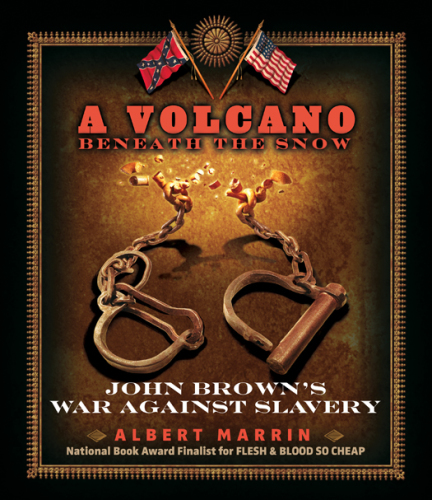
A Volcano Beneath the Snow
John Brown's War Against Slavery
فرمت کتاب
ebook
تاریخ انتشار
2014
Lexile Score
990
Reading Level
5-7
ATOS
7.7
Interest Level
6-12(MG+)
نویسنده
Albert Marrinشابک
9780385753401
کتاب های مرتبط
- اطلاعات
- نقد و بررسی
- دیدگاه کاربران
نقد و بررسی

Starred review from March 24, 2014
National Book Award finalist Marrin adds to his acclaimed collection of history books, and while the subject of this latestâfervent abolitionist John Brown and his efforts to end slavery in the United Statesâis not easy to read about, Marrin's narrative style is entirely accessible. Nine chapters effortlessly bridge topics that include Brown's upbringing, the global history of slavery, the âpeculiar institution" (as slavery was known in the preâCivil War south), and the legacy of Brown's actions. Marrin sets out âto place this man within his world and then to see how he helped bring about the most terrible conflict in American history," and he accomplishes that and more. The book winds down with Brown's execution, the Civil War, and President Lincoln's assassination, and a final chapter raises thoughtful topics for discussion. Should people in a lawful society follow the law or their own conscience? Was John Brown a martyr, a terrorist, or both? Archival photos, maps, and documents break up lengthy sections of text, and an index, notes, and suggestions for further reading are included. Ages 12 âup.

February 15, 2014
John Brown's fight to end slavery in the United States is presented in a broad historical context that reveals an impact far beyond the time it occurred. John Brown and his efforts to end slavery were integral aspects of the lead-up to the U.S. Civil War. Connecticut-born Brown's American roots were deep; one of his ancestors arrived on the Mayflower. Brown's religious fervor reflected that ancestry. Another shaping factor was his large family, as he experienced tragic losses and financial pressure to provide for them. The many difficulties he faced increased his sympathy for the downtrodden and served to intensify the abolitionist sympathies he learned from his father. In this detailed, archivally illustrated volume, Marrin broadly contextualizes the issues raised, considering the historical roots of slavery in the world, constitutional compromises that allowed it in the country's founding and the resistance to racial equality. His analysis of events encourages readers to explore the complexities that inform an event of this magnitude and what it can reveal about our own times. "He raised thorny questions about the use of violence at a time when democracy seemed ineffective and the road to justice blocked by self-interest, brutality, and racism," Marrin comments in an afterword that draws connections between Brown and modern-day terrorists both religious and secular. A comprehensive portrait of an ever-fascinating figure. (source notes, further reading, index [not seen]) (Nonfiction. 12 & up)
COPYRIGHT(2014) Kirkus Reviews, ALL RIGHTS RESERVED.

Starred review from March 1, 2014
Gr 7 Up-Marrin offers a multisided look at the events and controversy surrounding John Brown's role in the banishment of slavery and his ongoing inspiration for current events. Chapters present the history of the "peculiar institution" (slavery) both here and abroad, details of Brown's life and family, his relationship with the abolitionists, his radicalization leading to the killings at Pottawatomie, Kansas, and, eventually, the uprising at Harper's Ferry and his trial and hanging. Brown's motivations, his religious fervor, charisma, and leadership skills are all examined. The politics of the time and key players both for and against slavery, secession and disunion are introduced. Brown's role in the beginning of the Civil War and the introduction of the Emancipation Proclamation are explained. The role of slaves and free blacks before, during and after the war is also included. The Civil Rights Movement and more recent radical events, including the attack on the World Trade Center, are looked at through the lens of John Brown's actions. From beginning to end, readers are asked to consider the philosophical questions Brown raised regarding "breaking a 'bad' law in democracy." The double-column text is rich with relevant excerpts from writings, speeches, songs, and poetry of the era. Well-chosen captioned and dated black-and-white illustrations include period photos, portraits, artwork, maps, fliers, and posters. Extensive notes and further-reading suggestions are included. This will be an excellent resource for U.S. history collections.-Carol S. Surges, formerly at Longfellow Middle School, Wauwatosa, WI
Copyright 2014 School Library Journal, LLC Used with permission.

Starred review from March 15, 2014
Grades 8-12 *Starred Review* Historian Marrin regards the nineteenth-century zealot John Brown as being the father of American terrorism, a man who would use any means to effect what he believed was his God-given mission: to eradicate slavery in the U.S. In pursuit of his mission, the volcanic Brown didn't draw the line at violence or even murder, being personally responsible for a clutch of deaths in bloody Kansas. It is, however, his failed attempt to capture the federal armory at Harpers Ferry for which he is perhaps best remembered. It was his goal to seize the many guns stored there to arm an uprising of slaves that he hoped to foment. Though he didn't succeed, his failure was, in fact, a triumph, as his subsequent death by hanging turned him into a martyr, an inspiration for abolitionists, and a catalyst for the ensuing Civil War. Marrin has done a brilliant job of providing readers with a full-length biography of this extraordinary man who raised questions that are as valid today as they were in his lifetime. In limning Brown's colorful life, Marrin creates ample context, highlighting the horrors of slavery and offering an overview of the Civil War. His gracefully written, well-documented text is supported by 20 pages of endnotes and is accompanied by a generous selection of black-and-white period photographs and drawings. The result invites independent reading and provides an invaluable resource for classroom use.(Reprinted with permission of Booklist, copyright 2014, American Library Association.)

























دیدگاه کاربران